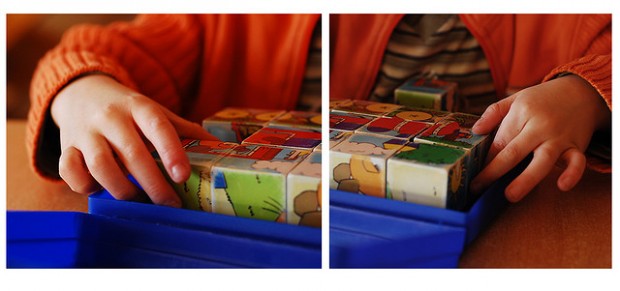All of us, children included, live in a three-dimensional universe—but too often parents and teachers act as if the physical world is as flat as a worksheet or the page of a book. We call kids’ attention to numbers and letters, but we neglect to remark upon the spatial properties of the objects around us: how tall or short they are, how round or pointy, how close or far. Growing evidence suggests that a focus on these characteristics of the material world can help children hone their spatial thinking skills—and that such skills, in turn, support achievement in subjects like science and math.
In a study published this month in the journal Developmental Psychology, for example, scientists from the University of Chicago reported that young children who understand how shapes fit together are better able to use a number line and to solve computation problems. Researcher Elizabeth Gunderson and her coauthors asked students in first and second grade to select the single shape from among four choices that would correctly complete a square. The kids who spotted the right shape also showed the most growth in their number-line knowledge over the following school year, and scored highest on a measure of mathematics ability at age eight.
How do children acquire spatial-thinking skills in the first place? Research shows that playing with blocks and puzzles helps. What’s really important, however, are the conversations that adults and children have as they interact with these toys, and as they observe the world around them. In a study published last year in the journal Mind, Brain, and Education, for example, Temple University psychology professor Nora Newcombe and her coauthors found that parents and children playing with blocks together were much more likely to use spatial terms like “over,” “around,” and “through,” than participants who played with a pre-assembled toy—and that it’s hearing and voicing such words that helps improve children’s spatial awareness.
Another 2011 study, this one from the University of Chicago, reported that the number of spatial terms (like “circle,” “curvy,” and “edge”) parents used while interacting with their toddlers predicted how many of these kinds of words children themselves produced, and how well they performed on spatial problem-solving tasks at a later age.
Why's this noteworthy? Spatial thinking skills, the researchers point out, are an important predictor of academic achievement and professional success in the STEM fields of science, technology, engineering, and mathematics, and these skills begin developing—or not—in children’s own homes. A large study called Project Talent, for example, “found that people who had high scores on spatial tests in high school were much more likely to major in STEM disciplines and go into STEM careers,” Newcombe, the Temple University psychologist, noted in a recent article in the journal American Educator. “Spatial thinkers are likely to be more interested in science and math than less spatial thinkers, and are more likely to be good enough at STEM research to get advanced degrees.”


